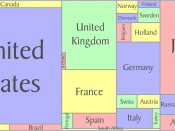Question 1: What are the industry's dominant economic features?This industry comprises establishments primarily engaged in record production (e.g., tapes, CDs). These establishments contract with artists and arrange and finance the production of original master recordings. Establishments in this industry hold the copyright to the master recording and derive most of their revenues from the sales, leasing, and licensing of master recordings. The music industry is one in which a five major companies have enjoyed exclusivity for some time now. The current macro-environment is one that is filled with differing technologies that are wreaking havoc with the business models of these five major record labels in the industry.
In terms of market size; the US recording industry revenue fell by $11 billion in 2006, down 25% from a 1999 peak of $14.6 billion, according to Yankee Group. The rise of digital music will compensate slightly for this loss, reaching $5.34 billion by 2012, up from $1.98
billion at the end of 2007. Additionally, California and New York account for 53% of revenues for this industry, where the majority of the entertainment business is located. In terms of revenue per employee: $212,769, well above the average earnings of employees in other sectors of the economy. (Serpick, 2007)(Yankee Group, 2008)There are currently five major labels competing in this market, along with an untold number of independent labels. The five majors are: BMG Entertainment, EMI, Sony Music Entertainment, Warner Music Group, and Universal Music Group. The record companies are essentially interdependent, when one company makes a move; it generally "forces" a response from its rivals. Rivalry increases as companies attempt to undercut each other's prices or offer customers more value in their products, pushing industry profits down in the process.
The x factor in the recording industry was that of Internet access in...


